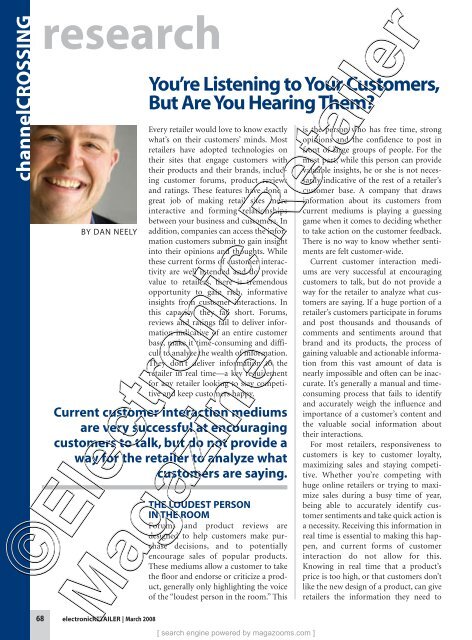March 2008 - Electronic Retailer Magazine
March 2008 - Electronic Retailer Magazine
March 2008 - Electronic Retailer Magazine
Create successful ePaper yourself
Turn your PDF publications into a flip-book with our unique Google optimized e-Paper software.
channelCROSSING<br />
research<br />
BY DAN NEELY<br />
68 electronicRETAILER | <strong>March</strong> <strong>2008</strong><br />
You’re Listening to Your Customers,<br />
But Are You Hearing Them?<br />
Every retailer would love to know exactly<br />
what’s on their customers’ minds. Most<br />
retailers have adopted technologies on<br />
their sites that engage customers with<br />
their products and their brands, including<br />
customer forums, product reviews<br />
and ratings. These features have done a<br />
great job of making retail sites more<br />
interactive and forming relationships<br />
between your business and customers. In<br />
addition, companies can access the information<br />
customers submit to gain insight<br />
into their opinions and thoughts. While<br />
these current forms of customer interactivity<br />
are well intended and do provide<br />
value to retailers, there is tremendous<br />
opportunity to gain rich, informative<br />
insights from customer interactions. In<br />
this capacity, they fall short. Forums,<br />
reviews and ratings fail to deliver information<br />
indicative of an entire customer<br />
base, make it time-consuming and difficult<br />
to analyze the wealth of information.<br />
They don’t deliver information to the<br />
retailer in real time—a key requirement<br />
for any retailer looking to stay competitive<br />
and keep customers happy.<br />
Current customer interaction mediums<br />
are very successful at encouraging<br />
customers to talk, but do not provide a<br />
way for the retailer to analyze what<br />
customers are saying.<br />
THE LOUDEST PERSON<br />
IN THE ROOM<br />
Forums and product reviews are<br />
designed to help customers make purchase<br />
decisions, and to potentially<br />
encourage sales of popular products.<br />
These mediums allow a customer to take<br />
the floor and endorse or criticize a product,<br />
generally only highlighting the voice<br />
of the “loudest person in the room.” This<br />
is the person who has free time, strong<br />
opinions and the confidence to post in<br />
front of large groups of people. For the<br />
most part, while this person can provide<br />
valuable insights, he or she is not necessarily<br />
indicative of the rest of a retailer’s<br />
customer base. A company that draws<br />
information about its customers from<br />
current mediums is playing a guessing<br />
game when it comes to deciding whether<br />
to take action on the customer feedback.<br />
There is no way to know whether sentiments<br />
are felt customer-wide.<br />
Current customer interaction mediums<br />
are very successful at encouraging<br />
customers to talk, but do not provide a<br />
way for the retailer to analyze what customers<br />
are saying. If a huge portion of a<br />
retailer’s customers participate in forums<br />
and post thousands and thousands of<br />
comments and sentiments around that<br />
brand and its products, the process of<br />
gaining valuable and actionable information<br />
from this vast amount of data is<br />
nearly impossible and often can be inaccurate.<br />
It’s generally a manual and timeconsuming<br />
process that fails to identify<br />
and accurately weigh the influence and<br />
importance of a customer’s content and<br />
the valuable social information about<br />
their interactions.<br />
For most retailers, responsiveness to<br />
customers is key to customer loyalty,<br />
maximizing sales and staying competitive.<br />
Whether you’re competing with<br />
huge online retailers or trying to maximize<br />
sales during a busy time of year,<br />
being able to accurately identify customer<br />
sentiments and take quick action is<br />
a necessity. Receiving this information in<br />
real time is essential to making this happen,<br />
and current forms of customer<br />
interaction do not allow for this.<br />
Knowing in real time that a product’s<br />
price is too high, or that customers don’t<br />
like the new design of a product, can give<br />
retailers the information they need to<br />
©<strong>Electronic</strong> ©<strong>Electronic</strong> <strong>Retailer</strong> <strong>Retailer</strong><br />
<strong>Magazine</strong> <strong>Magazine</strong><br />
[ search engine powered by magazooms.com ]





